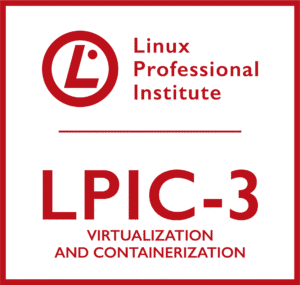
The LPIC-3 305 (also known as LPIC-3 305-300) is the most modern and cloud-ready specialization within the LPIC-3 certification track. This advanced Linux certification is ideal for senior-level professionals who work with virtualization technologies, containers, and cloud infrastructure.
In this article, you’ll discover why the LPIC-3 305 is a valuable certification, what topics it covers, and how it can help you stand out in today’s DevOps and cloud-driven job market.
Who Should Take the LPIC-3 Virtualization and Containerization?
The LPIC-3 305 certification is designed for experienced IT professionals who want to validate their skills in virtualization, containers, and cloud-native infrastructure. It is ideal for:
- Senior Linux administrators managing virtual machines and containerized workloads.
- DevOps engineers working with KVM, Docker, Kubernetes, and LXD.
- Cloud architects and systems engineers deploying and scaling cloud environments.
- IT infrastructure professionals and support analysts aiming to expand their expertise in modern Linux-based infrastructure.
- Professionals leading or planning enterprise-level cloud migrations and virtualization strategies.
This certification is especially relevant for roles such as:
- DevOps Engineer
- Cloud Systems Engineer
- Senior Linux Administrator
- Infrastructure Architect
- Site Reliability Engineer (SRE)
- IT Support Analyst
Why LPIC-3 305 Matters
In today’s fast-evolving IT landscape, skills in virtualization and containers are in high demand. Organizations are moving to hybrid and multi-cloud environments, relying on tools like QEMU/KVM, Docker and Kubernetes, for scalable and efficient infrastructure.
The LPIC-3 305 proves you can:
- Design and manage virtual environments using Linux-native tools.
- Deploy and orchestrate containerized applications.
- Automate infrastructure with provisioning and deployment tools.
- Lead cloud migration and modernization initiatives.
With this certification, you’re not just proving Linux knowledge, you’re validating your capability to work at the forefront of Cloud infrastructure and DevOps.
LPIC-3 305-300 Exam Overview
- Exam code: 305-300
- Prerequisite: Active LPIC-2 certification
- Format: 60 questions (multiple-choice and fill-in-the-blank)
- Duration: 90 minutes
- Available languages: English and Japanese
- Delivery: Pearson VUE or online (OnVUE)
- Validity: 5 years
Topics Covered
The LPIC-3 305-300 exam is divided into four main topic areas:
Topic 351: Virtualization
This topic focuses on open source hypervisor-based virtualization. It requires deep knowledge of the theory and application of full virtualization technologies, including:
- Understanding hypervisor architectures, particularly Xen and QEMU/KVM.
- Managing virtual machines using tools such as
libvirt,virsh, andvirt-manager. - Handling advanced VM operations such as snapshots, migrations, and disk image management (qcow2, raw, VMDK).
- Configuring virtual networks and storage.
This domain demonstrates your ability to deploy and manage robust, scalable VM environments, an essential skill for legacy and hybrid data centers.
Topic 352: Containers
Containerization is at the heart of modern application deployment, and this topic emphasizes:
- The underlying Linux kernel features that power containers (namespaces, cgroups, capabilities).
- Proficient use of LXC and LXD for system containers, including profiles, images, and resource limits.
- Hands-on Docker skills such as building images with Dockerfiles, managing volumes and networks, and deploying applications.
- Understanding container orchestration fundamentals with tools like Docker Compose, Docker Swarm, and Kubernetes.
Professionals mastering this topic can efficiently deploy containerized workloads and understand the key differences between system containers and application containers.
Topic 353: Virtualization Deployment and Provisioning Tools
This final topic area is all about automation, cloud integration, and infrastructure provisioning:
- Using cloud-focused tools such as Terraform and OpenStack.
- Building reproducible VM and container images using Packer.
- Automating first-boot and configuration tasks using
cloud-init. - Managing local development environments and testing labs with Vagrant.
Together, these skills allow you to automate infrastructure provisioning, support cloud migration efforts, and build efficient DevOps workflows.
Each domain reflects an essential aspect of the DevOps and Cloud journey, from VM infrastructure to lightweight containers to scalable and automated deployments. Mastering all three ensures you’re ready for modern enterprise infrastructure challenges.
How to Prepare for the Exam
To succeed on the LPIC-3 305-300 exam, it’s essential to:
- Get hands-on experience with QEMU/KVM, Docker, LXD, and other tools
- Study each objective from the official LPI 305-300 exam page
- Take a preparation course aligned with the exam topics
- Practice with mock exams to test your readiness
At Certify Linux, we offer a complete LPIC-3 305 course including:
- Expert-led video lessons
- Practice exams with explanations
- Support from a LPI certified instructor
Final Thoughts
If you’re looking to move into senior-level Linux roles focused on cloud-native infrastructure, LPIC-3 305: Virtualization and Containerization is one of the most relevant certifications available.
By earning thIS LPIC-3 credential, you’ll prove that you can manage complex, scalable systems using the most in-demand tools in modern IT.
Ready to get certified?
Check out our LPIC-3 305 Preparation Course and start advancing your Linux career today.